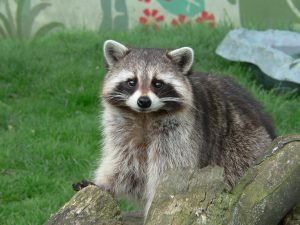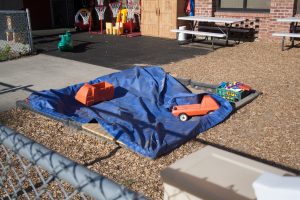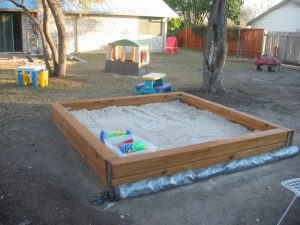Raccoons defecate in communal sites, called latrines. Raccoon feces usually are dark and tubular and have a pungent odor. – from Raccoon Latrines: Identification and Clean-up

Raccoons are pretty cute, but you really don’t want them pooping on the property. Photo: Nell McIntosh
When I was younger, raccoons were my favorite animal. It was hard to resist their clever little hands and cute bandit masks. My stuffed raccoon was named Rickie. Even when I was old enough to learn about rabies, my love didn’t wane. But then, when taking a wildlife rehabilitation workshop, I learned about Baylisascaris procyonis (raccoon roundworm), which is passed in raccoon feces. They recommended using a blowtorch to kill the eggs of this intestinal parasite which can enter the human eye and nervous system. The cuddly raccoon lost its place in my heart.
My love/hate relationship with raccoons came to mind when I saw the CDC has released a fact sheet on raccoon latrines and Baylisascaris procyonis. In it, they state “Young children or developmentally disabled persons are at highest risk for infection as they may be more likely to put contaminated fingers, soil, or objects into their mouths”, but fail to point out that sandboxes can serve as a raccoon latrine. (They do state it as a possibility here.) Of course, cats, which carry their own suite of parasites, are more likely to use sandboxes as their own personal litter box, so it is good IPM to prevent all types of animals from accessing your sandy play areas.
The easiest way to keep sandboxes from becoming litter boxes is to not have any sandboxes at all.

The idea is good, but the implementation is lacking. Without securing it, animals can easily slip under the tarp. Photo: Joellen Lampman
Bu, if you believe, like so many, that there are sensory and group play opportunities with sandboxes (just Google “sand play activities”), then there are steps you can take to prevent animals from gaining access.
- Keep sanitation a priority to avoid attracting wildlife – ensure that trash is cleaned up and put in a sealed container at the end of each day. (This will also help with other pests such as rats and yellow jackets.)
- Have a “no food in the sandbox” rule – there is no need to provide an enticement for local animals to check out the box.
- Pest proof your buildings (including outbuildings) to reduce den sites.
- Have a solid box bottom – not only will this help prevent sand loss, but will prevent animals from burrowing in from underneath.
- Have a durable cover on your box and make sure it is only uncovered during playtime.

Sandbox with cover rolled back. Photo: Gil Garcia

Tarp ties on the sandbox hold the tarp securely in place. Photo: Gil Garcia
If you find a latrine, check out the CDC fact sheet that includes information on cleaning it up while protecting your health. (Spoiler alert: they also recommend using a propane torch as chemicals will not kill the eggs.)
Just a note that raccoon latrines can be found in other areas, including (yikes!) inside buildings. Be sure to pest proof your buildings to prevent raccoons (and squirrels and bats and birds) from making your building their new den. To keep wildlife out of your buildings and discourage them from your grounds, visit the NYS IPM Program web page: What’s Bugging You: Wayward Wanderers.
